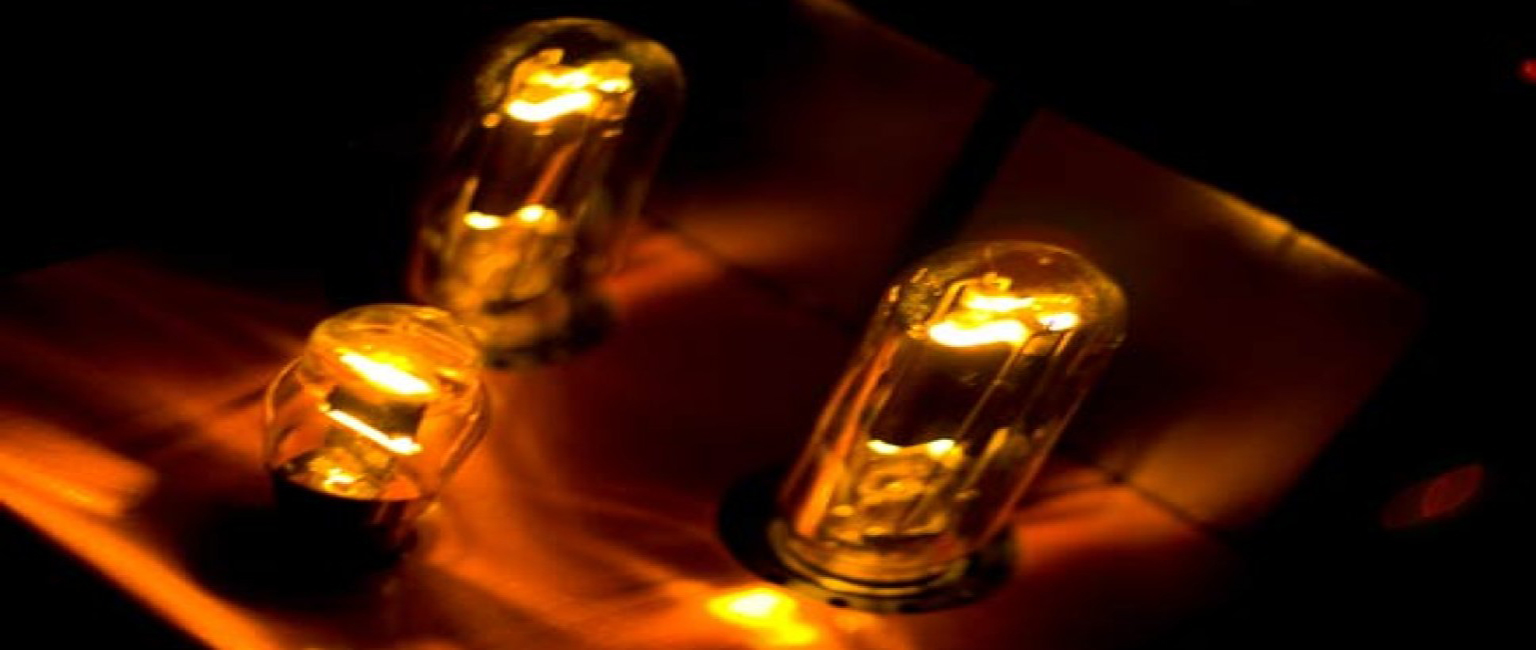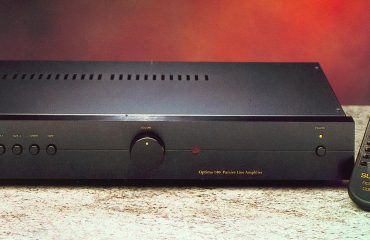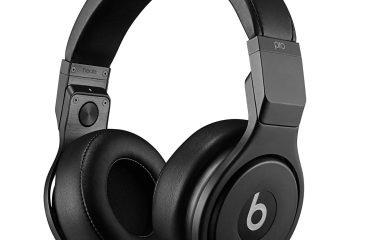
Visiting the zoo
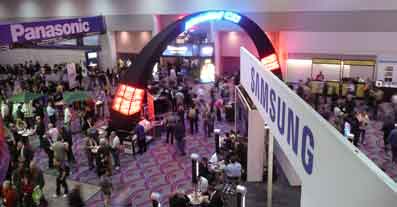 Here’s a clue: “the zoo” is the Las Vegas Convention Center. There are more exhibits here than anywhere else. The picture at right gives you only a minor indication of the look of the place. Even so, what you see is not one of the huge exhibit areas, but just the hallway outside one of the doorways.
Here’s a clue: “the zoo” is the Las Vegas Convention Center. There are more exhibits here than anywhere else. The picture at right gives you only a minor indication of the look of the place. Even so, what you see is not one of the huge exhibit areas, but just the hallway outside one of the doorways.
A glance around indicates the magnitude of the war among the makers of upscale television sets and connected technologies. We have never seen as many Panasonic banners as in this increasingly crowded and chaotic space. Inside there might have been fewer small booths than usual, but the TV manufacturers had their usual displays which were the size of small towns.
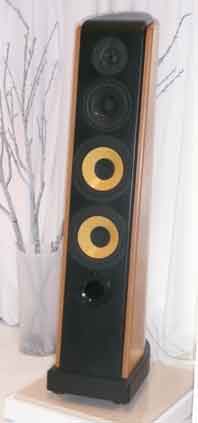
You can well imagine that the zoo is hardly the place you go to listen to high end audio. The cacophony is deafening, with the big exhibitors pumping out high-level dance music in an effort to create excitement and momentum. Yet we did hear two interesting loudspeakers. The first, at left, is from an unexpected source. It looks as though it could be a serious audio product, and it was being demonstrated under the best possible conditions, all things considered. We’ll tell you its name at the end of this report. Don’t peek, now!
Not unexpectedly, 3-D was everywhere, with some of the displays showing clips from James Cameron’s 3-D blockbuster, Avatar. The major difference from last year was that this time you could see 3-D without lining up to go into a dark chamber, though you could do that too. A significant number of the sets were showing 3-D, with glasses tethered so that they wouldn’t end up in a visitor’s pocket. Some clips were shown on special 3-D-ready screens, with polarized glasses, while others required LCD shutter glasses. Some displays had both. Panasonic, which had set the standard for the most convincing 3-D demonstrations last year, was a standout this year too, though it definitely had serious competition.
The big disappointment was the large exhibit by Sensio, the Canadian pioneer in 3-D television, which we’ve written about before (and which usually exhibits off-site). Though it had a large projection screen with an impressive clip from Monster House, the several TV screens around the area had images with visible scanning lines, something we hadn’t seen since the 1990’s. We talked to a Sensio engineer, who bristled and shifted into full defensive mode, denying he could see the scanning lines at all, and then claiming that all TV sets had them. They don’t, as a short stroll a few metres from the Sensio exhibit would have confirmed.
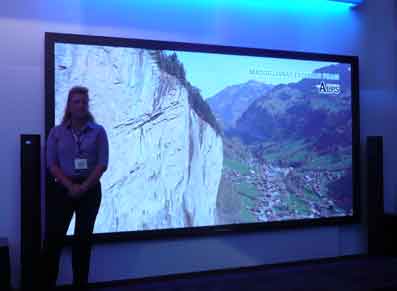 The most impressive TV image was from the awesome 152″ (386 cm) Panasonic Viera plasma panel shown at right. A screen that big could be expected to show up the limitations of even a 1080p image, but in fact Panasonic was displaying a picture with four times the normal resolution, 4096 by 2160 lines. A visitor who clearly hadn’t measured the doorway in his home asked how much it would cost him!
The most impressive TV image was from the awesome 152″ (386 cm) Panasonic Viera plasma panel shown at right. A screen that big could be expected to show up the limitations of even a 1080p image, but in fact Panasonic was displaying a picture with four times the normal resolution, 4096 by 2160 lines. A visitor who clearly hadn’t measured the doorway in his home asked how much it would cost him!
LCD displays, whether lit by LEDs or fluorescent tubes, greatly outnumbered plasma displays, and some of them came with truly outlandish claims for contrast ratio. The champion, as far as we could determine, was Toshiba, whose top LCD uses local dimming (simply turning off the backlighting in parts of the image in order to simulate blacker blacks) over 512 zones, to achieve a claimed contrast ratio of nine million to one! Talk about a specifications war! By the way, Toshiba calls the system KIRA2 Super Local Dimming, which of course calls up memories of Pioneer’s defunct Kuro sets, noted for their high contrast.
![]() We hadn’t seen anything truly new from Sharp for a while, but this year it had a true innovation, the addition of a fourth pixel, yellow, to accompany the usual blue, red and green pixels. In our picture at left, a smaller screen shows a greatly enlarged view of the individual pixels in the image. The display images were heavy on flower bouquets, including fields of sunflowers that would have delighted Van Gogh. It remains to be seen whether this potentially interesting innovation has staying power. We envisage competitors adding pink or chartreuse pixels to future sets.
We hadn’t seen anything truly new from Sharp for a while, but this year it had a true innovation, the addition of a fourth pixel, yellow, to accompany the usual blue, red and green pixels. In our picture at left, a smaller screen shows a greatly enlarged view of the individual pixels in the image. The display images were heavy on flower bouquets, including fields of sunflowers that would have delighted Van Gogh. It remains to be seen whether this potentially interesting innovation has staying power. We envisage competitors adding pink or chartreuse pixels to future sets.
We overheard a visitor asking an LG employee whether LED sets were truly better than LCD sets. The LG man politely pointed out that “LED” sets actually are LCD sets, with light-emitting diodes providing the illumination instead of an inferior fluorescent bulb.
 Even so, there is some (probably deliberate) confusion between LED edge lighting and full LED backlighting. LG was the company making the difference plain, because some of its sets, which you can see in this video wall, are edge-lit, while the more expensive ones have full LED backlighting. Do they look better? Yes they do, though a side-by-side comparison seemed pointless in such a brightly-lit environment.
Even so, there is some (probably deliberate) confusion between LED edge lighting and full LED backlighting. LG was the company making the difference plain, because some of its sets, which you can see in this video wall, are edge-lit, while the more expensive ones have full LED backlighting. Do they look better? Yes they do, though a side-by-side comparison seemed pointless in such a brightly-lit environment.
In issue No. 88 of UHF, we predicted that Boxee (www.boxee.tv), whose free software has not yet advanced to beta status, would have its own set-top box, as an alternative to a standalone PC or an Apple TV. That is now done, though we suspect the truncated Boxee cube was actually a mockup. For the moment Boxee lets you stream content from major US television networks, though it is widely anticipated that it will ultimately become a paid service, like cable.

In the same article we mentioned that Shuttle was one company whose PCs were small enough and quiet enough to be considered as adjuncts to an HDTV. Shuttle was showing a prototype of its XS35 computer, a full-blown PC the size of a wireless router. A DVD drive is included, and a dedicated Nvidia graphics card will be a welcome option. Shuttle has not yet decided whether this very small device can operate without a fan, but we’re hoping it can.
But now, back to the audio world. Though hi-fi is certainly incompatible with huge noise levels masquerading as music, it was possible to walk from the convention centre to the plush quiet of the Las Vegas Hilton, the rundown hotel that was long the biggest in Vegas. That’s where the KEF room was located.
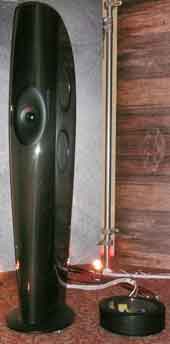 Last year KEF was showing the Muon, a sculpted aluminum speaker that looked not unlike the T1000 in Terminator 2 (the same speaker was shown at the Montreal Salon). This time it had a one-off pair of carbon fibre speakers, the Concept Blade. Possibly more practical (and commercially viable) than the Muon, it is however billed as a research demonstration, whose technology can trickle down into real products. The front driver is one of KEF’s dual Uni-Q units, while there are two woofers on each side. The crossover is in the round box on the floor.
Last year KEF was showing the Muon, a sculpted aluminum speaker that looked not unlike the T1000 in Terminator 2 (the same speaker was shown at the Montreal Salon). This time it had a one-off pair of carbon fibre speakers, the Concept Blade. Possibly more practical (and commercially viable) than the Muon, it is however billed as a research demonstration, whose technology can trickle down into real products. The front driver is one of KEF’s dual Uni-Q units, while there are two woofers on each side. The crossover is in the round box on the floor.
We would love to see this speaker actually reach production, because its sound is possibly the best we have heard this year. Despite the enclosure’s size, transient sounds, such as those of acoustic guitar, were both fast and natural. Brass was appropriately brash, but without a trace of the synthetic edginess that often passes for detail. Female voice (Peggy Lee singing Fever) was flawless. Of course the price would be high, but the Muon cost not far from $300,000, and we suspect that, when you get to that range, price no longer really matters.
And now it’s time to reveal the identity of the mystery speaker shown at the start of this report.
It’s from LG. The company is best known for its HDTV sets and its Chocolate mobile phone, but it has intentions to become a contender in serious audio. In a small room barely isolated from the sonic mayhem outside, a set of 5.1 speakers was playing a genuine audiophile recording of Mozart (from the 2L label), and doing it well. These speakers are prototypes, but we were told they will, at some point, be entering production.
One more day. We’ll be back at the Venetian to see some more of the high end rooms.

